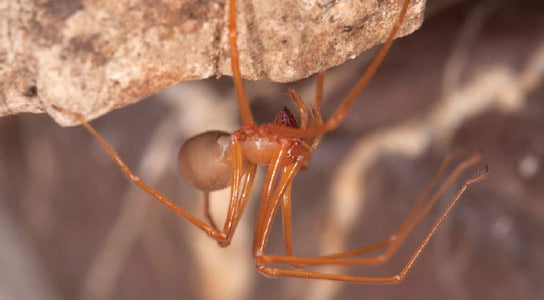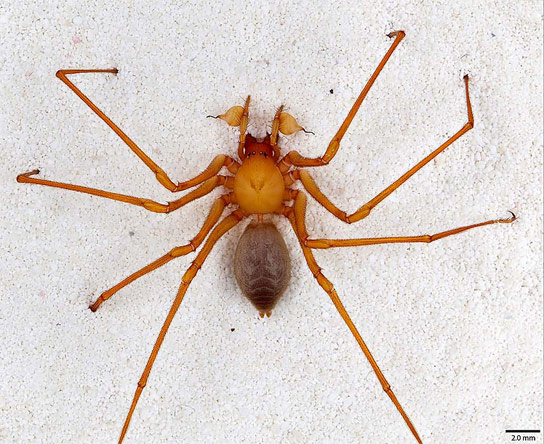Trogloraptor Marchingtoni Is a New Species of Spiders Discovered in the Pacific Northwest
August 20, 2012 by Range

A completely new genus and species of spiders was discovered in the Pacific Northwest, by spelunkers. Trogloraptor marchingtoni was first discovered by a group of amateur spelunkers in a cave in Grants Pass, Oregon 2010. They sent specimens to the California Academy of Sciences, who confirmed that it was a new species. Since then, more specimens have been found in the Redwoods of Northern California.
A team of entomologists led by Charles Griswold of the California Academy of Sciences, published their findings in the journal Zookeys. Griswold says that the discovery might explain the local legends of giant spiders. There have been only two other new spider families described since 1990. Norman Platnick, arachnologist, commented that the discovery was fascinating.

Adult T.marchingtoni have six eyes and a body length of about 7 to 10 mm. The body is yellow-brown in color, except for a dark brown V-shaped mark on the cephalothorax. The species can spin primitive webs with only a few strands, and hang off the roof of caves. The spiders are unique because of the flexible and teethed hook-like claws on the tarsus of their legs. The elongated claws resemble the ones of the Gradungulidae family of Australia and New Zealand, but these species are only distantly related.
The spiders uses the hooked claws to capture their prey, whose exact nature remains unknown as of yet. Captured live specimens were raised in controlled conditions, but died after refusing to eat moths, crickets and other spiders as food. This indicates that this species has a preference for a very specific yet unknown prey.
Trogloraptor Marchingtoni Is a New Species of Spiders Discovered in the Pacific Northwest
August 20, 2012 by Range

A completely new genus and species of spiders was discovered in the Pacific Northwest, by spelunkers. Trogloraptor marchingtoni was first discovered by a group of amateur spelunkers in a cave in Grants Pass, Oregon 2010. They sent specimens to the California Academy of Sciences, who confirmed that it was a new species. Since then, more specimens have been found in the Redwoods of Northern California.
A team of entomologists led by Charles Griswold of the California Academy of Sciences, published their findings in the journal Zookeys. Griswold says that the discovery might explain the local legends of giant spiders. There have been only two other new spider families described since 1990. Norman Platnick, arachnologist, commented that the discovery was fascinating.

Adult T.marchingtoni have six eyes and a body length of about 7 to 10 mm. The body is yellow-brown in color, except for a dark brown V-shaped mark on the cephalothorax. The species can spin primitive webs with only a few strands, and hang off the roof of caves. The spiders are unique because of the flexible and teethed hook-like claws on the tarsus of their legs. The elongated claws resemble the ones of the Gradungulidae family of Australia and New Zealand, but these species are only distantly related.
The spiders uses the hooked claws to capture their prey, whose exact nature remains unknown as of yet. Captured live specimens were raised in controlled conditions, but died after refusing to eat moths, crickets and other spiders as food. This indicates that this species has a preference for a very specific yet unknown prey.
No comments:
Post a Comment